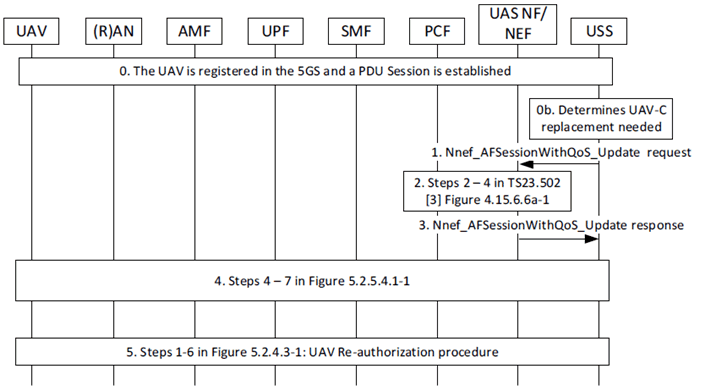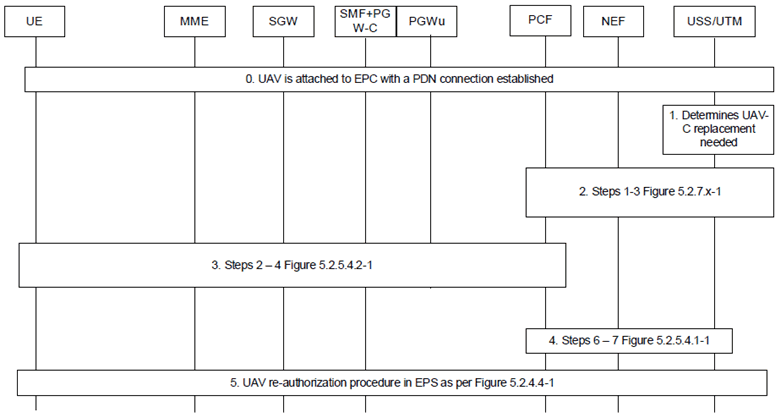Content for TS 23.256 Word version: 19.1.0
1…
4…
4.2…
4.2.3…
4.3…
4.4…
4.5…
5…
5.2.3…
5.2.4…
5.2.5…
5.2.5.3…
5.2.5.4…
5.2.7
5.2.8…
5.2.9…
5.3…
5.4…
5.5…
5.12…
5.13…
5.14…
6…
6.2…
6.3…
6.3.4…
A…
5.2.8 UAV Controller Replacement
5.2.8.1 UAV controller replacement in 5GS
5.2.8.2 UAV controller replacement in EPS
...
...
5.2.8 UAV Controller Replacement p. 56
5.2.8.1 UAV controller replacement in 5GS p. 56
If USS determines that UAV controller replacement is required the USS invokes an Nnef_AFsessionWithQoS_Update service operation to the UAS NF including in the request authorization information (i.e. new pairing information). NEF authorizes the request from the USS followed by interacting with PCF triggering a Npcf_PolicyAuthorization_Update request and provides relevant parameters to the PCF. The PCF uses the information provided by the NEF to derive new PCC rules to allow C2 communication between the UAV and the new UAV controller.
The procedure for UAV-C replacement is as follows:

Step 0.
A UAV has already established user plane connectivity for C2 operation. The USS determines that the UAV-C controlling the UAV needs to be replaced (e.g. if the UAV is misbehaving).
Step 1.
The USS initiates the UAV-C replacement by invoking the Nnef_AFSessionWithQoS_Update request including Transaction Reference ID, UAV-UAVC Pairing info/Flow description(s), QoS reference. See step 1 in clause 4.15.6.6a of TS 23.502, AF session with required QoS update procedure.
Step 2.
NEF authorizes the request from the USS followed by interacting with PCF triggering a Npcf_PolicyAuthorization_Update request and provides relevant parameters to the PCF. PCF determines whether the request is authorized and if the requested QoS is allowed. PCF informs NEF if the request is accepted by invoking Npcf_PolicyAuthorization_Update Response. See Steps 2 - 4 in TS 23.502 Figure 4.15.6.6a-1.
Step 3.
NEF sends a Nnef_AFsessionWithQoS_Update response message (Transaction Reference ID, Result) to the USS. Result indicates whether the request is granted or not. See step 5 in TS 23.502 Figure 4.15.6.6a-1.
Step 4.
Steps 4 - 7 in Figure 5.2.5.4.1-1.
Step 5.
USS invokes the UAV Re-authorization procedure in Figure 5.2.4.3-1 to deliver the new pairing information to the UE. The USS includes the 3GPP UAV ID, the IP address of the PDU session and included in the authorization message the C2 Authorization Result and the C2 Authorization Payload (containing the C2 pairing information containing the new UAV-C identifier and C2 security information) which is further forwarded to the UE.
5.2.8.2 UAV controller replacement in EPS p. 57
The procedure for UAV-C replacement in EPS is as follows:

Step 0.
UAV is attached to EPC with a PDN connection established
Step 1.
The USS determines that the UAV-C controlling the UAV needs to be replaced (e.g. if the UAV is misbehaving).
Step 2.
USS initiates the Nnef_AFSessionWithQoS_Update request including USS Identity/AF Identifier, Transaction Reference ID, UAV-UAVC Pairing info/Flow description(s), QoS reference. Steps 1-3 as in Figure 5.2.7.1-1 takes place.
Step 3.
The PCF determines updated policy information and configures the resources and routing information as in steps 2 - 4 in Figure 5.2.5.4.2-1.
Step 4.
The USS is informed whether the UAV-C replacement and authorization has succeeded or failed as in steps 6- 7 in Figure 5.2.5.4.1-1.
Step 5.
The USS invokes the UAV re-authorization procedure in EPS as in Figure 5.2.4.4-1. The USS includes the 3GPP UAV ID, the IP address of the PDU session and included in the authorization message, the C2 Authorization Result and the C2 Authorization Payload (e.g. containing the C2 pairing information containing the new UAV-C identifier and C2 security information) which is further forwarded to the UE.